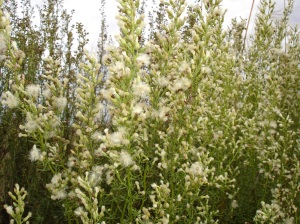Artigo cedido gentilmente pelo Professor Dr. Domingos Sávio Nunes
Universidade Estadual de Ponta Grossa
I send here to you a brief review on the toxicity of Baccharis coridifolia with fulltext citations online.
I also send reminders to our data published recently on the volatile metabolites of male and female specimens of five species of the genus Baccharis[Besten et al., 2012]. In that work, B. coridifolia collected in our region appeared as one of the five cases analyzed.
Baccharis coridifolia – the poisonous shrub
One of the most important plants responsible for the poisoning of cattle in South America is Baccharis coridifolia. This herbaceous shrub is a characteristic representative of the savannah vegetation of Southern Brazil, Uruguay, Paraguay, and Argentina. Although the plant has been known to be toxic since the beginning of the 20th century, no experimental work was formally published before 1975. All parts of the plant are toxic, but the flowers, leaves and seeds are particularly dangerous. Death occurs between 4 h and 34 h following the ingestion of a lethal amount of the plant (0.35 g/kg body weight). More than 50.000 animals die in Brazil per year from this plant [1].
An outbreak of B. coridifolia poisoning in sheep is reported, which occurred in southern Brazil [2]. From a herd of 212 sheep, coming from a B. coridifolia free area, 35 sheep died until 5 days after the arrival in the new area where the plant was found with abundance. The clinical signs began 8 hours after introduction of the animals into the new pasture and included apathy, anorexia, abdominal retraction or mild distension, weakness of hind limbs, dry feces, sternal ou lateral decumbency, struggling movements, coma and death. Clinical evolution was from 5 to 48 hours. Other sheep that were already before on the pasture were not affected. Several other cases of poisoning with B. coridifolia have been reported in Brazil, including cattle [3-7].
Recent research work brings interesting experimental results showing that all sheep that ingest B. coridifolia or are treated with LiCl develope an aversion to corn for the whole experimental period. After one year, sheep were transferred to a pasture with B. coridifolia, and observed for plant consumption. Sheep that were treated with B. coridifolia the previous year, did not graze the plant. It was demonstrated that B. coridifolia is as efficient as LiCl in conditioning an aversion to a previously unknown food [8].
References on line
[1] Isolation and structure of new toxins from plants. Pure & Appl. Chem. 61(3): 377-380, 1989. [fulltext]
[2] Intoxicação espontânea por Baccharis coridifolia (Compositae) em ovinos. Pesq. Vet. Bras. 26(1): 21-25, 2006. [fulltext]
[3] Intoxicação experimental por Baccharis coridifolia (Compositae) em bovinos. Pesq. Vet. Bras. 18(2): 69-74, 1998. [fulltext]
[4] Intoxicação espontânea por Baccharis coridifolia em bovinos. Pesq. Vet. Bras. 25(2): 111-114, 2005. [fulltext]
[5] Microhistological analysis of sheep gastro-intestinal content to confirm poisonous plant ingestion. Journal of Range Management 51(6): 955-960, 1996. [fulltext]
[6] Acute toxic plant estimation in grazing sheep ingesta and feces. Journal of Range Management 56(4): 353-357, 2003. [fulltext]
[7] Histopathological examination of lymphoid organs in cattle and mice experimentally poisoned by Baccharis coridifolia: Immunohistochemical characterization of B and T lymphocytes. Braz. J. vet. Res. anim. Sci. 45(4): 277-283, 2008. [fulltext]
[8] Conditioned aversion in sheep induced by Baccharis coridifolia. Applied Animal Behaviour Science 117: 197–200, 2009. [fulltext]http://naturaetchimia.wordpress.com/
Link:

Nenhum comentário:
Postar um comentário